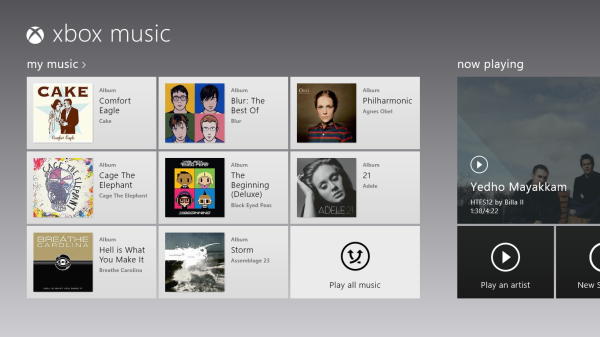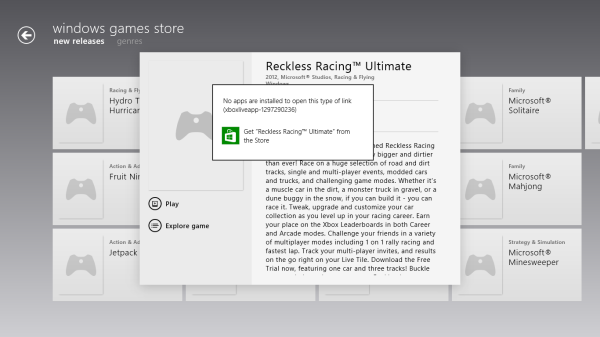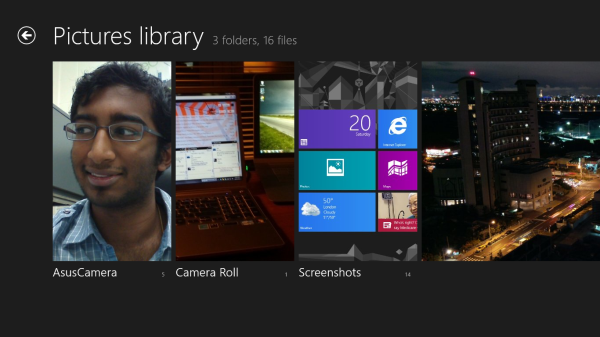The Windows RT Review
by Vivek Gowri & Anand Lal Shimpi on October 25, 2012 12:00 PM EST- Posted in
- Windows RT
- Operating Systems
- Microsoft
- Mobile
- Windows 8
- Tablets
Xbox Live: Music, Video, and Gaming
The music and video players are now part of the Xbox Live family of services, so they’re connected to Xbox Music and Xbox Video respectively. The applications are separate but are very similarly designed and laid out, with local content on the left, featured content in a central location, and content stores to the right. The bottom edge swipe brings up the ability to specify a file for playback, as well as a now-playing control bar. The music application looks quite good when snapped to the edge, with various album art from your library appearing as the background for the music controls.
Hilariously, videos can also be played back when snapped, albeit in a very small window. It’s not the best way to watch a video (who enjoys watching video content in a 320x180 window? Anyone? No takers?) but you can do it if you really want to. The video playback controls are pretty elegant in full-screen mode, and both players seem to have taken a number of interface design cues from the Zune software. I’m a huge fan of the Zune desktop software and how elegantly it operates, so I think this is great. I’m also just glad to not have to deal with Windows Media Player.
Both Xbox Music and Xbox Video look very similar to the latest Xbox dashboard update, and it’s clear that Microsoft is pushing a unified entertainment content front here. I remember when Microsoft was supporting a half dozen different music stores when the original Zune launched in 2006, so I’m just glad that they’re finally consolidating all of their services and concentrating on a single content store. Xbox has been their most successful entertainment effort to date, so it’s no surprise to see Microsoft put their faith in it for media as well.
Now, we can’t discuss Xbox without touching on gaming. Xbox Live is obviously the gaming portal of choice for Windows RT, and offers various hubs for Windows and Xbox 360 games. The Xbox Live application didn’t appear to be ready at the time of posting, with broken links and missing pictures for all the games and hubs. This is still an unreleased software (until Friday, anyways) so it’s possible that we’ll see the application be updated between now and then for a working final release. We will also have to wait until then to see what game support will be like out of the box; currently, the Xbox Windows Game store shows titles like Reckless Racing, Hydro Thunder Hurricane, Fruit Ninja, Cut the Rope, and a number of Microsoft classic titles like Minesweeper and Solitaire, amongst others.
Camera and Photos
The camera application is about as basic as you can get, with a translucent control bar that lets you switch cameras, change between still and video capture modes, set up a timer, and basic picture quality settings. Basic isn’t necessarily a bad thing though, as the application operates smoothly and quickly, with near-instant switching between modes and cameras. The controls are very straightforward - tap and hold to lock exposure is supported, and to capture an image you can just tap anywhere on the screen. It’s one of the easiest capture mechanisms out there, and fits right in with the simple UI.
The photo application pulls images from your local pictures folder and camera roll, as well as being able to connect to Facebook, Flickr, and SkyDrive. They show up as panels for each service, which show a full list of thumbnails. It’s worth pointing out that you can only see photos uploaded to Facebook from your own account, not friend’s images or pictures you’ve been tagged in. As is now the norm with tablet picture galleries, you can view images in slideshow form or just flick through them individually. For local images, the bottom edge swipe brings up an option to delete the images, as well as setting as the lockscreen image and starting a slideshow. For images on Facebook, there’s an option to view them in Facebook, though you need to actually be signed into Facebook in IE for this to work.
The overall takeaway from the camera and gallery applications is that they’re designed as minimally as possible and do exactly what they’re supposed to with a minimum of fuss. You won’t see any spectacular functionality, though the ability to slideshow through Facebook galleries is a nice touch. I think we’ll see manufacturers offer their own spin on these applications, like ASUS and their separate camera application, in an attempt to gain minor levels of platform differentiation. Microsoft has kept a pretty tight reign on the customizations allowed for the Windows Phone platform though, so I can’t see them allowing anything too invasive on Windows RT devices either.















233 Comments
View All Comments
Sherlock - Friday, October 26, 2012 - link
IMHO WIndows RT on ARM is an stop-gap solution till the x86 architecture becoms power efficient to give tablet like running times. I belive Microsoft began working on Surface about two years ago & at that point of time, there was no viable competitor to ARM, in terms of power efficiency. This is the primary reason I belive Microsoft had to create an ARM version.Several of the commentators on this site have mentioned that they see no reason to buy an ARM over x86...and it definitley makes sense. Why have an fragmented ecosystem?
I believe that as time passes on & people get used to the Modern UI & the x86 architecture catches up, Microsft would phase out their support for the ARM version.
Microsoft could have chosen to do away with the "Desktop" environment with Windows RT & created a Moder UI version of Office (I don't agree with the argument of they not having enough time...they have been at it for 2 years) but I guess they deliberately chose to retain it so that users experience the familiar environment while using their killer app in this war - Office. I think people have underestimated the importance of bundling Office with Windows RT which remediates the biggest shortcoming of Android/iOS tablets
prdola0 - Friday, October 26, 2012 - link
Hi, the article is nice, but I keep wondering about one thing. Why do Apple articles start with a nice and colorful image of the devices, and a lot of it's competition articles start with a smudgy ugly images or devices turned off? Maybe it's just accidental, but please give it a thought. It looks a bit like bias.B3an - Friday, October 26, 2012 - link
Lol i've said this before! They often put more effort in to images taken of Apple stuff, which i've never liked as it's bias in way.But to be fair, this time the image at the start of this article is old and to show the Win 7 tablet. It makes sense to have it with the opening of the article.
beginner99 - Friday, October 26, 2012 - link
...but doubtful very usable in practice. I really like the thinking behind Surface with the touch keyboard cover and other things. According to this review Windows 8 isnt that bad on tablets. I'm just gonna believe that.However the Application load times are very, very bad. 7 sec for mail app? That is just frustrating. Just shows that ARM is still very much underpowered....Or that surface uses an extremely crappy flash storage.
milkod2001 - Friday, October 26, 2012 - link
@prdola0this site belongs to Anand a trully Apple fanboy plus there's no such thing as unbiased review, any review on any web is only as good/positive as much is reviewer/site owner getting pay
yyrkoon - Sunday, October 28, 2012 - link
Funny, I thought the review was rather in favor for Microsoft. This review, and the Microsoft surface review. Both.Anand is no dumbie.. I absolutely HATE anything Apple based on pure personal beliefs / reasoning. Yet, even I, can not deny that iOS as far as polish goes is second to none. Until now. And the hardware used is usually top quality.
At a higher cost, with less freedom, and a strangle hold on their software regime. A lot of people claim these are all problems from Microsoft. Which may be true, but Apple trumps Microsoft in computer-land tyranny. Until now.
It could be that 90% of the market will be driven to using Mint Linux x, in the not so distant future. We'll see if Microsoft gets another clue.
GnillGnoll - Friday, October 26, 2012 - link
I very much like that the on-screen keyboard has cursor keys, even if it's just left/right. It's one of the main features missing from the iOS keyboard, as precisely positioning the cursor with your finger is a huge pain.I assume that Ctrl+Left/Right skips words, and that Shift+Left/Right can be used for selection. Does anyone know if there is a way to go up/down?
I don't like that quick access to punctuation is so limited, though.
bitbank - Friday, October 26, 2012 - link
From your comments throughout the article, it's clear that you're a fan of Metro and you overlook many of the shortcomings of Windows Phone and Windows RT just because of the "smooth tiled interface". The truth is that the GUI isn't that important. It's not where you get your work done. Apps are where you work.As you said, an ARM version of Windows is good to wake Intel from their slumber and get some competition in the low cost/low power CPU market. Intel's Sandy Bridge and Ivy Bridge processors get decent battery life and run 3-5x faster than the best ARM offerings to date. I get 8-10 hours of battery life out of my 17" HP Sandy Bridge notebook with the medium capacity battery. I would much rather have an x86 slate running Windows 8 with support for legacy apps. Having a half-baked version of Office on an ARM based WinRT tablet isn't much incentive to be stuck with virtually no apps.
WindowsRT feels a lot like the launch of Windows CE notebooks. Interesting form factors and improved battery life don't make up for lack of app compatibility. The value of Windows is in its huge selection of apps. Win8 Pro is taking the right approach. Similar to the transition from DOS and 16-bit to 32-bit apps with Windows 95, there needs to be a transition product (Win8 Pro) which bridges the gap between old and new. When presented with a completely new device with no legacy support and very little app support, it makes very little sense for the average user to buy it. Besides reviewers and people who have to buy the latest gadget, why should an average person want to buy WinRT? According to you, they should patiently wait for the app store to get some decent apps. That's asking too much. The smart move for the average consumer is to wait a year or so and see if developers have given any attention to Windows 8's "little brother" and published apps in both x86 and ARM versions.
karocage - Friday, October 26, 2012 - link
But the interface is how you navigate all those apps. It's legitimate to point out that WP7 and W8/RT have clearly surpassed iOS in terms of speed of navigation between things like the back button, hubs, task switcher, charms and so on. That's not a function of the tiles really - although of course the tiles are another place where MS has a much better implementation than Apple.steven75 - Friday, November 2, 2012 - link
Completely disagree on speed of navigation. Are you familiar with the four-finger swipes on an iPad to switch apps, bring up the "task manager" tray, etc?I'll give you getting to the settings screen to find apps settings takes longer but thankfully on iOS apps launch lightning fast unlike on RT.